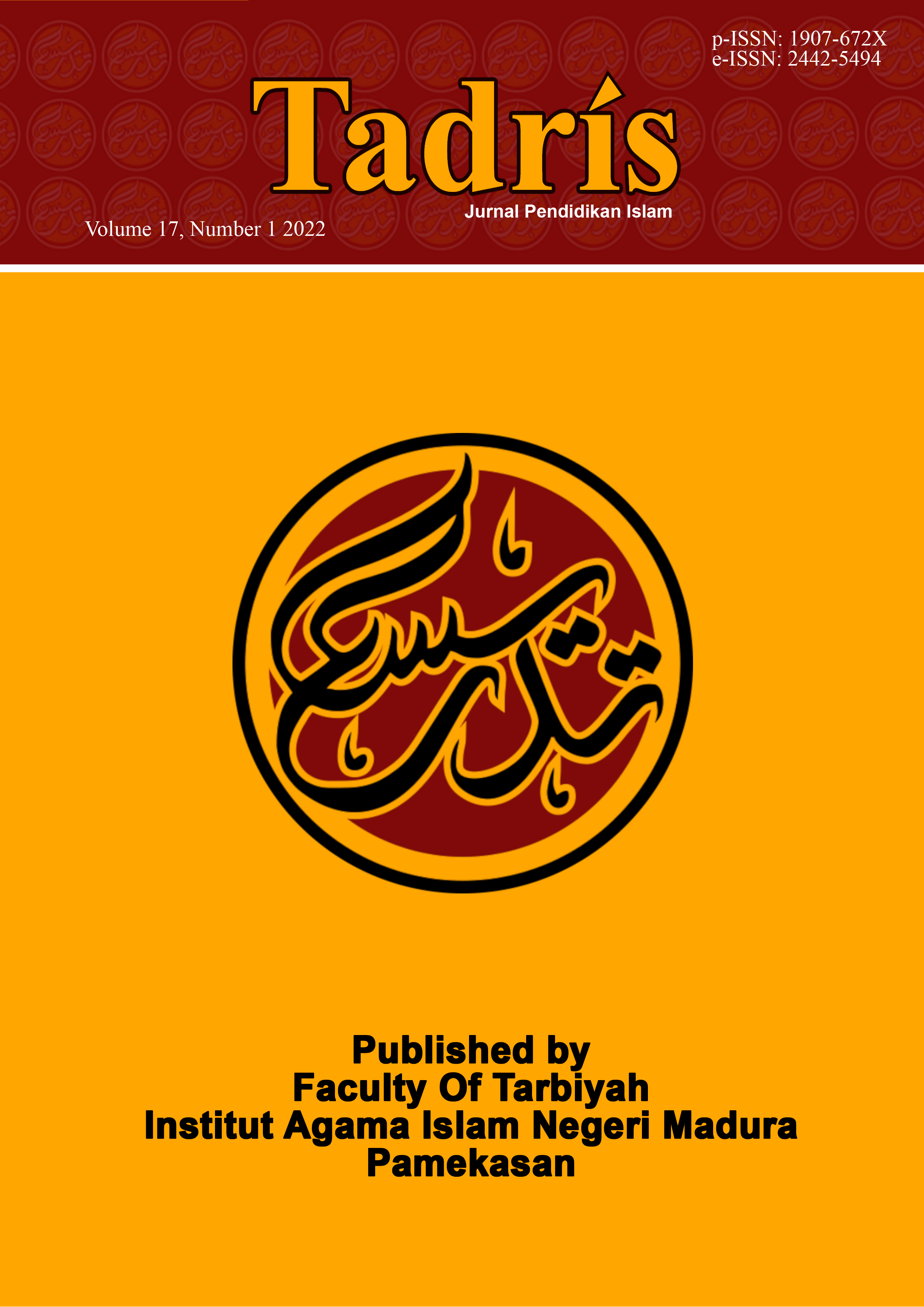Curriculum Innovation: a Comparasion Between the Goals and the Facts on 2013 Curriculum Implementation at Madrasah Aliyah in Kabupaten Tolitoli
 Abstract views: 261
,
Abstract views: 261
,
 PDF downloads: 206
PDF downloads: 206
Abstract
Curriculum 2013 (K13) is one form of innovation in the field of education initiated by the Indonesian government. It is necessary to explore adopters' perceptions of this innovative product as a top-down innovation model. The adoption of an innovative product is strongly influenced by, among others, the adopter's perspective on the product's relative advantage, compatibility, and complexity. This study examines the influence of these three factors on the decisions of teachers (adopters) in adopting or implementing K13 in their learning practices. This problem is studied using a mixed-method, quantitative method as the primary approach and supported by a qualitative approach. The regression analysis test results show a combined effect of the relative advantage, compatibility, and complexity factors on implementing K13 with a correlation of 18.2%. Still, partially there is no influence between the factors of advantage and complexity on the implementation of K13. This shows that the adoption of K13 innovation is more widely accepted as a necessity, not because of a positive perception of K13 itself. Their lack of knowledge of K13 influences the adopter's perception of K13 at the concept and implementation techniques level. The results of this study recommend the need for intensive training for teachers in optimizing the implementation of K13 as expected.
Downloads
References
Bostad, Inga, and Aled Dilwyn Fisher. “Curriculum and Social Change in Education for a Sustainable Future?” In Human Rights in Language and STEM Education, edited by Babaci-Wilhite Z, 71–90. Rotterdam: SensePublishers, 2016.
Budiani, Sri, Sudarmin, and Rodia Syamwil. “Evaluasi Implementasi Kurikulum 2013 Di Sekolah Pelaksana Mandiri.” Innovative Journal of Curriculum and Educational Technology 6, no. 1 (2017): 45–57.
Budiwati, Neti, Sumartini, and Ani Pinayani. “Tantangan Profesionalisme Dan Kesiapan Guru Mengimplementasikan Kurikulum 2013.” Jurnal Ekonomi Pendidikan dan Kewirausahaan 4, no. 1 (2016): 92–100.
E.Mulyasa. Pengembangan Dan Implementasi Kurikulum 2013. Bandung: PT Remaja Rosdakarya, 2013.
Edquist, Charles, and Bjorn Johnson. “Institutions and Organizations in Systems of Innovation.” In Systems of Innovation: Technologies, Institutions and Organizations, edited by Charles Edquist, 31:333. London and New York: Routledge, 1998.
Gaynor, Gerard H. “Innovation: Top down or Bottom Up.” IEEE Engineering Management Review 41, no. 3 (2013): 5–6.
Hariatiningsih, Ayu Novia. “Implementasi Kebijakan Kurikulum 2013 ( Studi Deskriptif Peraturan Menteri Pendidikan Nomor 160 Tahun 2014 Tentang Pemberlakuan Kurikulum Tahun 2006 Dan Kurikulum 2013 Tingkat SMA Dan SMK Di Kabupaten Blitar ).” Kebijakan dan Manajemen Publik 4, no. 2 (2016): 64–70.
Ibrahim. Inovasi Pendidikan. Jakarta: Departemen Pendidikan dan Kebudayaan, 1988.
Kartowagiran, Badrun, Heri Retnawati, Sutopo, and Faridl Musyadad. “Evaluation of The Implementation of Curriculum 2013 Vocational High School In Indonesia.” In International Conference on Educational Research and Innovation, 814–819, 2017.
Kementerian Pendidikan dan Kebudayaan. Peraturan Menteri Pendidikan Dan Kebudayaan Republik Indonesia. Republik Indonesia, 2013.
Kunandar. “Menakar Keberhasilan Implementasi Kurikulum 2013.” Kompasiana, December 30, 2015. https://www.kompasiana.com/kunandar/menakar-keberhasilan-implementasi-kurikulum-2013_5683ff75709773050ba881ef.
Machali, Imam. “Kebijakan Perubahan Kurikulum 2013 Dalam Menyongsong Indonesia Emas Tahun 2045.” Jurnal Pendidikan Islam 3, no. 1 (2014): 71.
OECD-Eurostat. Oslo Manual: Guidelines for Collecting and Interpreting Innovation Data. 3rd ed. Paris: OECD Publishing, 2005.
OECD. Innovating Education and Educating for Innovation: The Power of Digital Technologies and Skills. Paris: OECD Publishing, 2016.
Rasyidi, Muhammad. “Inovasi Kurikulum Di Madrasah Aliyah.” Al Qalam: Jurnal Ilmiah Keagamaan dan Kemasyarakatan 13, no. 1 (2019): 33–50.
Rogers, Everett M. Diffusion of Innovations. 3rd Edition. London: Coller Macmillan Publisher, 1995.
Ruja, I Nyoman, and Sukamto. “Survey Permasalahan Implementasi Kurikulum Nasional 2013 Mata Pelajaran Ilmu Pengetahuan Sosial Sekolah Menengah Pertama Di Jawa Timur.” Jurnal Sejarah dan Budaya 11, no. 2 (2015): 193–199.
Subandi. “Pengembangan Kurikulum 2013 (Studi Analitis Dan Subtantif Kebijakan Kurikulum Nasional).” Terampil Jurnal Pendidikan dan Pembelajaran Dasar 1, no. 1 (2014): 18–36.
Suhardan, Dadang. Supervisi Profesional. Bandung: Alfabeta, 2010.
Suharsaputra, Uhar. Administrasi Pendidikan. Bandung: Refika Adtama, 2010.
Sumarni. “Evaluation of the Implementation of 2013 Curriculum in Madrasah.” Puslitbang Pendidikan Agama dan Keagamaan Badan Litbang dan Diklat Kementerian Agama Jl. 15, no. 3 (2017): 387–404.
“ICW Kritik Kurikulum 2013.” Republika, August 29, 2014. http://www.republika.co.id/berita/koran/didaktika/14/08/29/nb23g85-icw-kritik-kurikulum-2013.
Copyright (c) 2022 TADRIS: Jurnal Pendidikan Islam

This work is licensed under a Creative Commons Attribution-NonCommercial 4.0 International License.
The journal operates an Open Access policy under a Creative Commons Non-Commercial 4.0 International license. Authors who publish with this journal agree to the following terms:
- Authors retain copyright and grant the journal right of first publication with the work simultaneously licensed under a
 Commons Attribution-NonCommercial 4.0 International License
Commons Attribution-NonCommercial 4.0 International Licensethat allows others to share — copy and redistribute the material in any medium or format, and adapt — remix, transform, and build upon the material.
- Authors are able to enter into separate, additional contractual arrangements for the non-exclusive distribution of the journal's published version of the work (e.g., post it to an institutional repository or publish it in a book), with an acknowledgement of its initial publication in this journal.
- Authors are permitted and encouraged to post their work online (e.g., in institutional repositories or on their website) prior to and during the submission process, as it can lead to productive exchanges, as well as earlier and greater citation of published work (see The Effect of Open Access).














